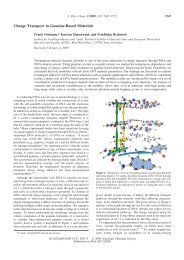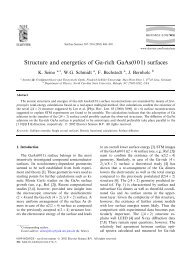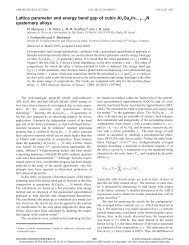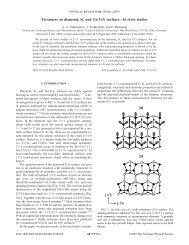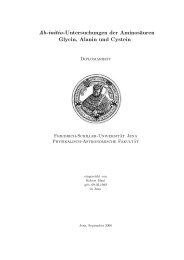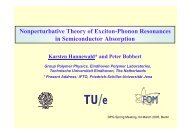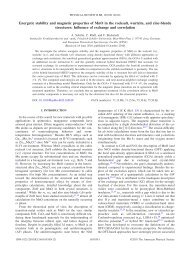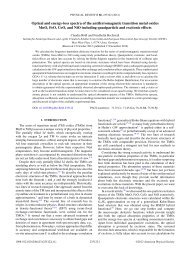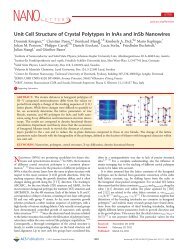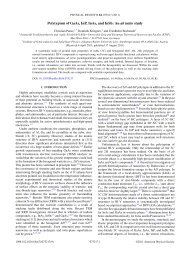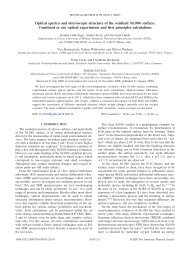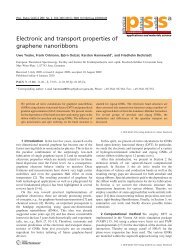Beyond the GW approximation - APS Link Manager - American ...
Beyond the GW approximation - APS Link Manager - American ...
Beyond the GW approximation - APS Link Manager - American ...
You also want an ePaper? Increase the reach of your titles
YUMPU automatically turns print PDFs into web optimized ePapers that Google loves.
BEYOND THE <strong>GW</strong> APPROXIMATION: COMBINING ... PHYSICAL REVIEW B 85, 155131 (2012)<br />
<strong>the</strong> T matrix reads,<br />
Ō σ 1 ¯σ 1 ,(2)<br />
ij<br />
(ω) = Ō σ 1 ¯σ 1 ,(1)<br />
ij<br />
(ω) + U ∑ 3 n<br />
and <strong>the</strong> two self-energies become<br />
pp,σ 1,(2)<br />
ij<br />
(ω)<br />
= σ 1,(1)<br />
ij<br />
(ω) + U 3 {<br />
16<br />
[<br />
− 1 2t<br />
1<br />
ω − 3t + iη +<br />
eh,σ 1 (2)<br />
ij<br />
(ω)<br />
= σ 1,(1)<br />
ij<br />
(ω) − U 3<br />
16<br />
− 1 2t<br />
[<br />
{<br />
1<br />
ω − 3t + iη +<br />
L σ 1 ¯σ 1<br />
0,in (ω)Lσ 1 ¯σ 1<br />
0,nj<br />
(ω), (59)<br />
1<br />
(ω − 3t + iη) − (−1)(i−j)<br />
2 (ω + 3t − iη) 2<br />
(−1)(i−j)<br />
ω + 3t − iη<br />
]}<br />
, (60)<br />
1<br />
(ω − 3t + iη) − (−1)(i−j)<br />
2 (ω + 3t − iη) 2<br />
(−1)(i−j)<br />
ω + 3t − iη<br />
]}<br />
. (61)<br />
Combining <strong>the</strong> two interaction channels by adding Eqs. (60)<br />
and (61), <strong>the</strong> second terms on <strong>the</strong> right-hand side of <strong>the</strong> two<br />
equations cancel each o<strong>the</strong>r, thus restoring <strong>the</strong> exact result if<br />
1<br />
2 (pp,(2) + eh,(2) ) is taken. We have already shown in Eq. (25)<br />
that <strong>the</strong> sum 1 2 (pp,(2) + eh,(2) ) takes into account some of <strong>the</strong><br />
terms that would appear in <strong>the</strong> self-energy if also <strong>the</strong> functional<br />
derivative δO/δG were considered. This might justify <strong>the</strong><br />
exact result that is obtained by taking 1 2 (pp,(2) + eh,(2) ). Also<br />
<strong>the</strong> sum ( pp,(2) + eh,(2) ) takes into account some of <strong>the</strong> terms<br />
arising from <strong>the</strong> functional derivative [see Eq. (25)]; however,<br />
it does not give <strong>the</strong> exact result. In o<strong>the</strong>r words it seems more<br />
important to take into account <strong>the</strong> term −T 0 than (T 1 + T 2 )/2<br />
[see Eqs. (24) and (25)] at least in <strong>the</strong> present problem.<br />
However, with <strong>the</strong> third iteration, <strong>the</strong> fourth-order terms in<br />
<strong>the</strong> pp and eh T -matrix self-energies are <strong>the</strong> same and <strong>the</strong>y<br />
would not cancel each o<strong>the</strong>r if <strong>the</strong> sum 1 2 (pp,(2) + eh,(2) )is<br />
taken. Instead, with <strong>the</strong> fourth iteration, <strong>the</strong> fifth-order terms in<br />
<strong>the</strong> pp and eh T -matrix self-energies would cancel each o<strong>the</strong>r.<br />
In general, for <strong>the</strong> present problem, <strong>the</strong> pp and eh T -matrix<br />
self-energies show, starting from second order, <strong>the</strong> same<br />
even-order terms and opposite odd-order terms, as one can<br />
verify Taylor expanding <strong>the</strong> frequency-dependent part of <strong>the</strong><br />
pp and eh self-energies [Eqs. (53) and (54)] for small U. The<br />
same holds for <strong>the</strong> Hubbard model at 1/4 filling. Therefore,<br />
summing <strong>the</strong> two contributions will not give <strong>the</strong> exact result.<br />
Even adding <strong>the</strong> <strong>GW</strong> self-energy terms and its exchange<br />
counterparts, in <strong>the</strong> spirit of <strong>the</strong> FLEX <strong>approximation</strong>, will<br />
not produce <strong>the</strong> exact result. These findings show that <strong>the</strong>re<br />
is no an ultimate way to combine diagrams, and this is of<br />
clear relevance for realistic studies where several attempts<br />
to combine pp and eh channels have been done (see, e.g.,<br />
Refs. 28–30 and 35). A possibility is to use <strong>the</strong> screened T<br />
matrix we introduced in Sec. II B3, which produces, at least<br />
for <strong>the</strong> studied problem, results that are overall better than<br />
those from <strong>the</strong> <strong>GW</strong> and T matrix, as shown in <strong>the</strong> following.<br />
2. Screened T matrix<br />
The pp screened T matrix with <strong>the</strong> approximate on-site<br />
static Coulomb interaction W = U − 2U 2 t/h 2 (with h 2 =<br />
4t 2 + 4Ut) leads to <strong>the</strong> self-energy<br />
pp,σ<br />
s,ij (ω) = U 2 δ ij + UWt [<br />
1<br />
4 ˜h ω − t − ˜h + iη<br />
]<br />
+ (−1)(i−j)<br />
ω + t + ˜h − iη<br />
(62)<br />
10<br />
6000<br />
4000<br />
exact and 1st iteration pp/eh T matrix<br />
pp T matrix<br />
pp screened T matrix<br />
<strong>GW</strong><br />
U/2t<br />
5<br />
2000<br />
ω/t<br />
0<br />
∝ √U/2t<br />
-2000<br />
-5<br />
-4000<br />
-U/2t<br />
-10<br />
0<br />
2<br />
4<br />
U/t<br />
6<br />
8<br />
-6000<br />
10<br />
2 3 4 5 6 7 8 9<br />
10 4<br />
Log (U/t)<br />
t . A σ (ω)<br />
FIG. 7. Two-site Hubbard model at 1/2 filling: Comparison between <strong>the</strong> exact renormalized addition/removal energies ω/t (solid lines) as<br />
a function of U/t (left panel) and log(U/t) (right panel) and <strong>the</strong> results obtained from <strong>GW</strong> (dashes) and particle-particle (dots) and screened<br />
T matrix (triangles). In <strong>the</strong> atomic limit, <strong>the</strong> spectral function, i.e., <strong>the</strong> peak positions and weights, is illustrated on <strong>the</strong> right-hand side, on<br />
multiplying by t and taking <strong>the</strong> t → 0 limit.<br />
155131-11



